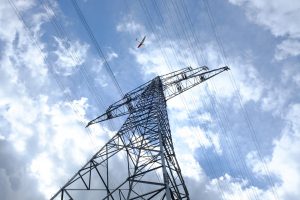
Electricity transmission company RTE and Delair-Tech set a new distance record this morning when they flew a civilian drone 30 miles (50 kilometers). Officially, the flight’s mission was to inspect RTE’s power lines and record data that will result in models of RTE’s European power grid.
BVLOS flight has been legal in France since 2012, and Delair-Tech’s commercial drones were designed for long endurance flight. Today’s record-setting flight added a 3G communication network to guide the drone to the Delair-Tech solution.
French authorities granted Delair-Tech and RTE permissions to use a specific flight corridor and perform the flight. Two pilots at launch and two pilots at landing were used to manage the mission, although the flight was performed autopilot with the GPS data integration within the drone.
“More flexible to use, the UAV offers a complementary solution to helicopter inspections for network maintenance conducted by the RTE. This first 30 miles flight illustrates the RTE’s commitment to constant innovation that contributes to electricity that is safer, cheaper, and more respectful of the environment,” said Patrick Bortoli, Director of Maintenance RTE.
“We are delighted to partner with RTE, confirming that renowned industrial customers are committed to drone solutions. In collaboration with RTE, we used for the first time in France a 3G network to guide the drone, allowing real-time communication from any distance. This removes an important technological barrier. It is a first step toward making drones the most common method for inspections of infrastructure that stretches over large distances, such as power lines and pipelines. Drones offer enormous potential to deliver strong efficiency gains for our customers,” said Michael Lagarde, President & Co-Founder of Delair-Tech.
“RTE has been experimenting with the use of drones in its operations since 2011. The company in 2016 began using drones more extensively for shorter-range inspections of its electricity transmission network and its cable laying,” says the company. “RTE hopes to one day be using drones for longer-range missions, which could help reduce the cost, mitigate the danger of inspections on infrastructure that is remote and difficult to access, and avoid long interruptions to electricity service when maintenance must be done.”
BVLOS flight is not yet legal in the US, although the FAA has promised that BVLOS flight and flight over people will be prioritized as drone regulation moves forward. BVLOS flight regulations could enable many commercial applications such as railway or electricity grid inspections and drone delivery.

Miriam McNabb is the Editor-in-Chief of DRONELIFE and CEO of JobForDrones, a professional drone services marketplace, and a fascinated observer of the emerging drone industry and the regulatory environment for drones. Miriam has penned over 3,000 articles focused on the commercial drone space and is an international speaker and recognized figure in the industry. Miriam has a degree from the University of Chicago and over 20 years of experience in high tech sales and marketing for new technologies.
For drone industry consulting or writing, Email Miriam.
TWITTER:@spaldingbarker
Subscribe to DroneLife here.